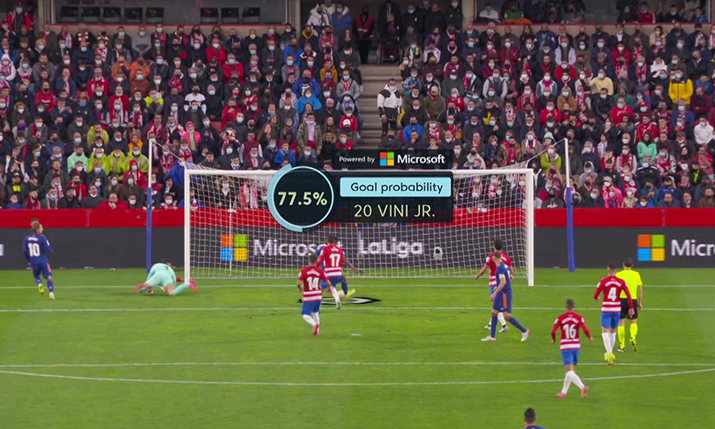Goal Probability graphic to be added to replays in LaLiga coverage

LaLiga is going to make a Goal Probability graphic available to directors working on coverage of its matches from this weekend.
The stat, which has come about as part of the league’s tie-up with Microsoft, will be ready to send to air as part of goal replays within 30 seconds of the action taking place and will show the likelihood of the goal being scored based on a player’s position, angle and historical efficiency.
Microsoft Azure’s artificial intelligence and machine learning is the basis for the new innovation.
The league believes that the graphical data will help viewers to “understand first-hand just how good a goalscoring chance actually was” and give them “a more personalised experience and quality information that helps them to interpret and enjoy the game.”
Discussing the project, LaLiga Tech general director Miguel Ángel Leal said: “Thanks to the strength of Microsoft Azure, we are managing to improve the experience for our fans by incorporating this model that calculates the probability of a goal being scored.
“The algorithms we’ve developed are based on artificial intelligence and require a very high computing power in order to work through a very large number of data points and offer these stats almost in real-time. The work being carried out by our team of data scientists at LaLiga Tech, as part of our alliance with Microsoft, makes it possible to present innovations that are pioneering in the industry, such as this sophisticated Goal Probability model.”
“The capacity of this technology has allowed LaLiga to take another step forward, becoming the first league to bring a metric with these characteristics into its broadcasts.”
The new metric was built based on an in-house model from the football analysts at LaLiga’s Mediacoach, who worked along with the Business Intelligence & Analytics team of LaLiga Tech, the technological subsidiary of the organisation.
The Mediacoach platform is capable of capturing almost 3.5 million positioning data points per match, which translates into some 2,000 metrics per player and which helps to create particularly reliable stats.
The main innovation, according to LaLiga, which sets this stat apart from those offered by other platforms, is the incorporation via graphics of the metric at the frame level and during a live match, which also take into account the goalscoring efficiency of the player involved in the piece of play.
It said that it is possible to incorporate, almost in real-time, the player’s historic stats into the broadcast during the second replays of a goal.
Microsoft is LaLiga’s global Tech and Innovation Partner. Various projects are being developed with the aim of “digitally transforming the sports and entertainment industry.”
Rebeca Marciel, the enterprise commercial lead at Microsoft Spain, added: “Microsoft’s Machine Learning & Artificial Intelligence technology has facilitated this development, thanks to the analysis of historical tracking data of more than 20,000 shots obtained from some 2,000 matches. The capacity of this technology has allowed LaLiga to take another step forward, becoming the first league to bring a metric with these characteristics into its broadcasts.”
Should that goal have been scored? The secret of the metric.
LaLiga and Microsoft’s Goal Probability stat analyses well-defined parameters through a mathematical model that determines how each of these variables affects the likelihood of a goal being scored or not scored.
During a match, real-time data on the positioning of the players is received thanks to the 16 optical tracking cameras that are installed in each stadium of the league and, from there, each parameter is calculated and the model runs the numbers to obtain the Goal Probability.
The perfected metric is based on a variety of different variables, such as the player’s line of sight, which considers the positions of the opposition players in the way of the player’s view to goal, which has a decisive impact on the difficulty and, in turn, the probability of finishing the chance.
Other factors taken into consideration include the distance between the ball and the goalkeeper and between the ball and the goal, or the distance and angle to the nearest defender. This produces a final stat that is shown on the screen.
The lower the probability figure for scoring a goal that has, in fact, gone in, the more efficient the shot must have been in relation to what should have been expected of the player.
The model returns probabilities between 0% and 100%, providing the viewer with an insight into the golden opportunities that were wasted, or the goals that were scored from a nearly impossible position. In the case of LaLiga, the figure shown will also take into consideration the goalscoring efficiency of the player in question.

